The best Lemon Vinaigrette Recipe
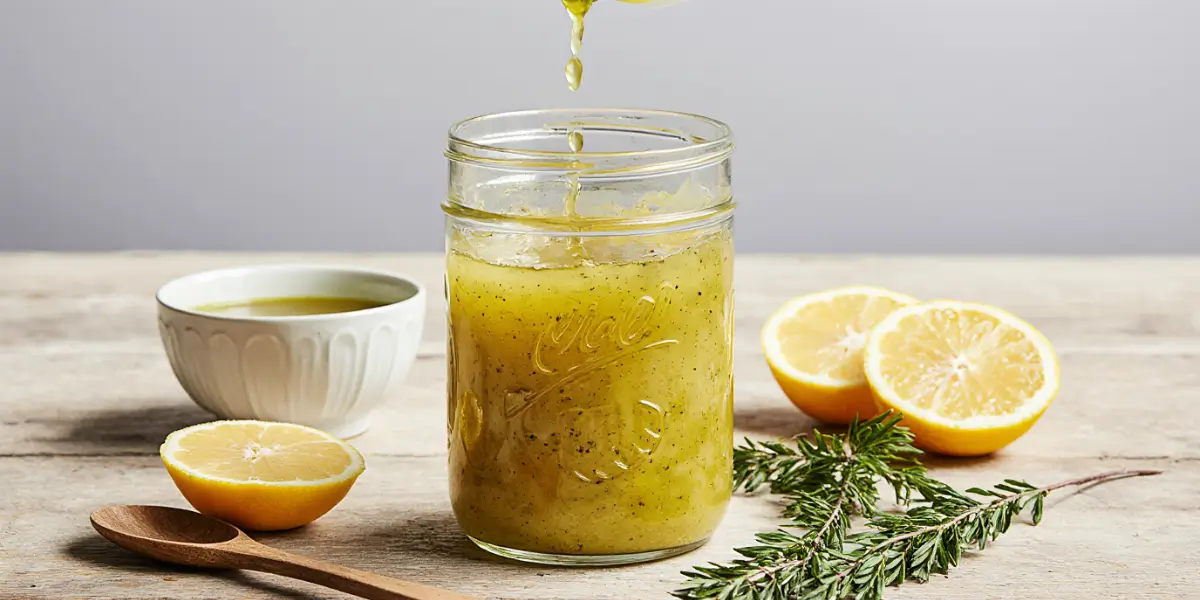
Picture this: you’re standing in your kitchen, staring at a bowl of fresh greens, knowing something’s missing. You reach for that store-bought dressing bottle, shake it, and pour—only to taste that artificial, overly sweet flavor that masks rather than enhances your beautiful salad. Sound familiar? You’re not alone. Millions of home cooks settle for mediocre dressings when the perfect lemon vinaigrette recipe is just five minutes away from transforming your salads forever.
The magic of a homemade lemon vinaigrette lies in its simplicity and versatility. This isn’t just another salad dressing—it’s your ticket to elevating everything from simple mixed greens to roasted vegetables, grilled proteins, and even grain bowls. When you master this essential lemon vinaigrette recipe, you’ll wonder why you ever bought dressing from a bottle.
Why This Lemon Vinaigrette Recipe Will Change Your Salad Game
The Perfect Balance of Bright and Bold Flavors
Creating the ideal lemon vinaigrette recipe starts with understanding the fundamental principle of balance. Unlike heavy, cream-based dressings that can overwhelm delicate greens, a well-crafted lemon vinaigrette enhances every ingredient it touches. The bright acidity of fresh lemon juice cuts through rich foods while the olive oil provides smoothness and helps your body absorb fat-soluble vitamins from your vegetables.
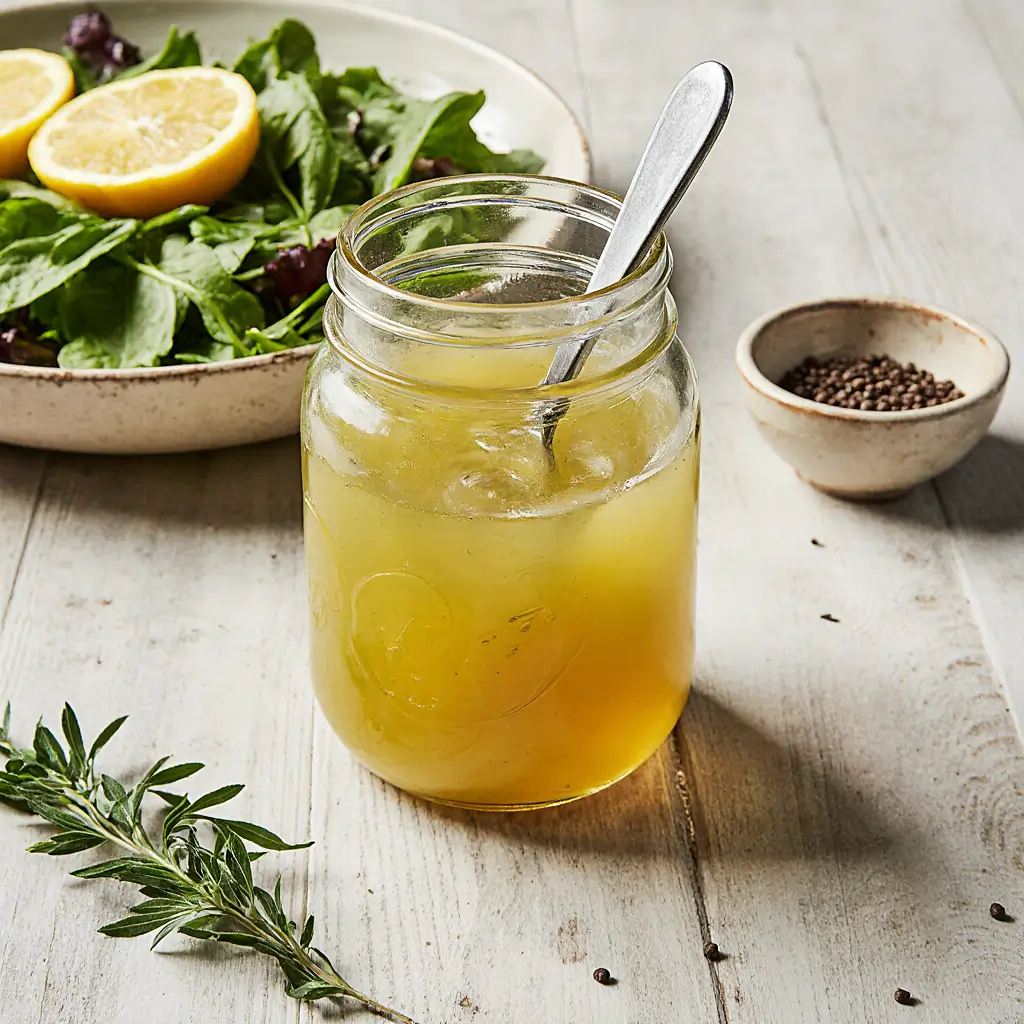
Your taste buds crave complexity, and this lemon vinaigrette recipe delivers exactly that. The sharp tang of citrus plays beautifully against the peppery notes of good olive oil, while a touch of Dijon mustard adds depth and helps create that perfect emulsion. When you add fresh herbs or garlic, you’re building layers of flavor that make each bite interesting.
Health Benefits That Go Beyond Taste
Beyond flavor, this lemon vinaigrette recipe offers impressive nutritional benefits. Fresh lemon juice provides vitamin C, which supports your immune system and helps with iron absorption from leafy greens. The healthy monounsaturated fats in olive oil support heart health and help reduce inflammation in your body.
Unlike commercial dressings loaded with preservatives, high fructose corn syrup, and artificial flavors, your homemade lemon vinaigrette contains only wholesome ingredients you can pronounce. You control the sodium content, the quality of oil, and can adjust sweetness to your preference. This means you’re nourishing your body while satisfying your taste buds.
Cost-Effective Kitchen Wisdom
Making your own lemon vinaigrette recipe isn’t just healthier—it’s incredibly economical. A single bottle of quality store-bought vinaigrette often costs more than the ingredients needed to make five times that amount at home. When you break down the cost per serving, homemade vinaigrette costs pennies compared to dollars for commercial versions.
You probably already have most ingredients in your pantry: olive oil, lemons, salt, and pepper. The initial investment in quality olive oil pays dividends across countless meals, and fresh lemons have multiple uses beyond salad dressing. This lemon vinaigrette recipe helps you maximize your grocery budget while improving your meals.
Essential Ingredients for the Perfect Lemon Vinaigrette Recipe
Choosing Your Liquid Gold: Olive Oil Selection
The foundation of any exceptional lemon vinaigrette recipe is high-quality olive oil. Extra virgin olive oil provides the best flavor profile, offering fruity, peppery, or grassy notes depending on the variety. Look for oil in dark bottles or tins, which protect against light damage, and check the harvest date—fresher is always better.
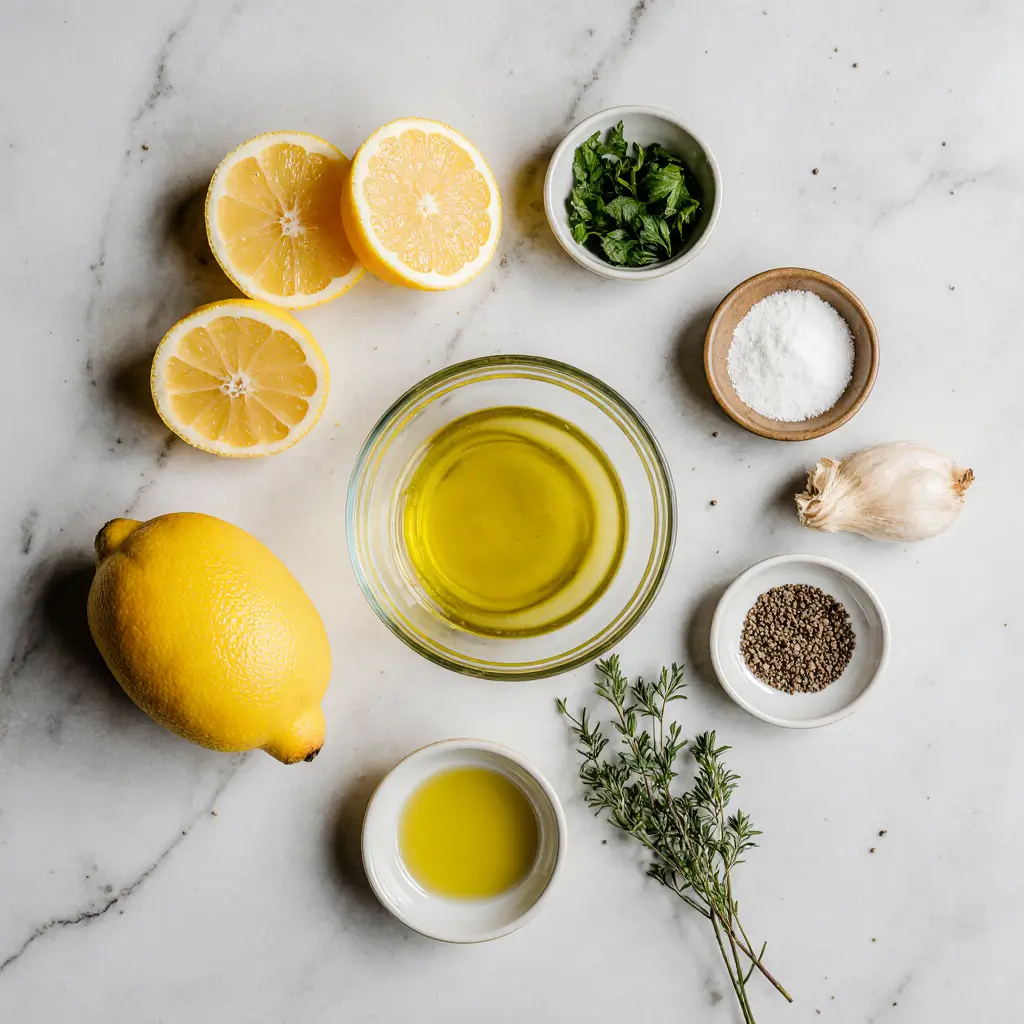
Different olive oils bring unique characteristics to your lemon vinaigrette recipe. Spanish oils tend to be robust and fruity, perfect for hearty salads with bitter greens. Italian oils often have a more delicate, herbaceous quality that pairs beautifully with tender lettuces. Greek oils typically offer a bold, peppery finish that stands up well to strong flavors like feta cheese or olives.
For everyday use, find a medium-intensity extra virgin olive oil that balances flavor with versatility. Avoid light or refined olive oils in your lemon vinaigrette recipe—they lack the complexity that makes homemade dressing special. Store your olive oil in a cool, dark place and use within six months of opening for optimal flavor.
The Star of the Show: Fresh Lemon Juice
Fresh lemon juice is non-negotiable in an authentic lemon vinaigrette recipe. Bottled lemon juice lacks the bright, complex flavor of fresh citrus and often contains preservatives that can create off-tastes in your dressing. Plan to use about one large lemon per quarter cup of vinaigrette, though this varies based on the lemon’s size and juiciness.
Choose lemons that feel heavy for their size with smooth, thin skins—these typically yield more juice. Room temperature lemons release juice more easily than cold ones, so leave them on your counter for an hour before juicing. Roll the lemon firmly on your counter while pressing down to break internal membranes and maximize juice extraction.
When preparing your lemon vinaigrette recipe, strain the fresh juice to remove pulp and seeds, which can create texture issues and may turn bitter over time. However, if you enjoy a bit of zest in your dressing, finely grate some lemon peel for an extra burst of citrus oils and flavor complexity.
Supporting Players That Make the Difference
Dijon mustard serves as both a flavor enhancer and an emulsifier in your lemon vinaigrette recipe. Just half a teaspoon helps bind the oil and acid together, creating a smoother, more stable dressing. The mustard also adds a subtle tang and complexity that elevates the overall flavor profile.
Salt and freshly ground black pepper are crucial for balancing and enhancing all other flavors in your lemon vinaigrette recipe. Use fine sea salt or kosher salt, which dissolves easily and provides clean flavor without additives. Freshly ground pepper offers more complex, aromatic qualities than pre-ground versions.
Consider optional ingredients that can customize your lemon vinaigrette recipe: minced garlic for pungency, fresh herbs like basil or thyme for aromatic complexity, or a small amount of honey for subtle sweetness that balances the acidity. These additions allow you to tailor the dressing to specific salads or personal preferences.
Step-by-Step Instructions for the Ultimate Lemon Vinaigrette Recipe
The Classic Whisking Method
Start your lemon vinaigrette recipe by combining the acid and seasonings in a medium bowl. Add two tablespoons of fresh lemon juice, half a teaspoon of Dijon mustard, half a teaspoon of salt, and a few grinds of black pepper. Whisk these ingredients together until the salt dissolves completely and the mixture is well combined.
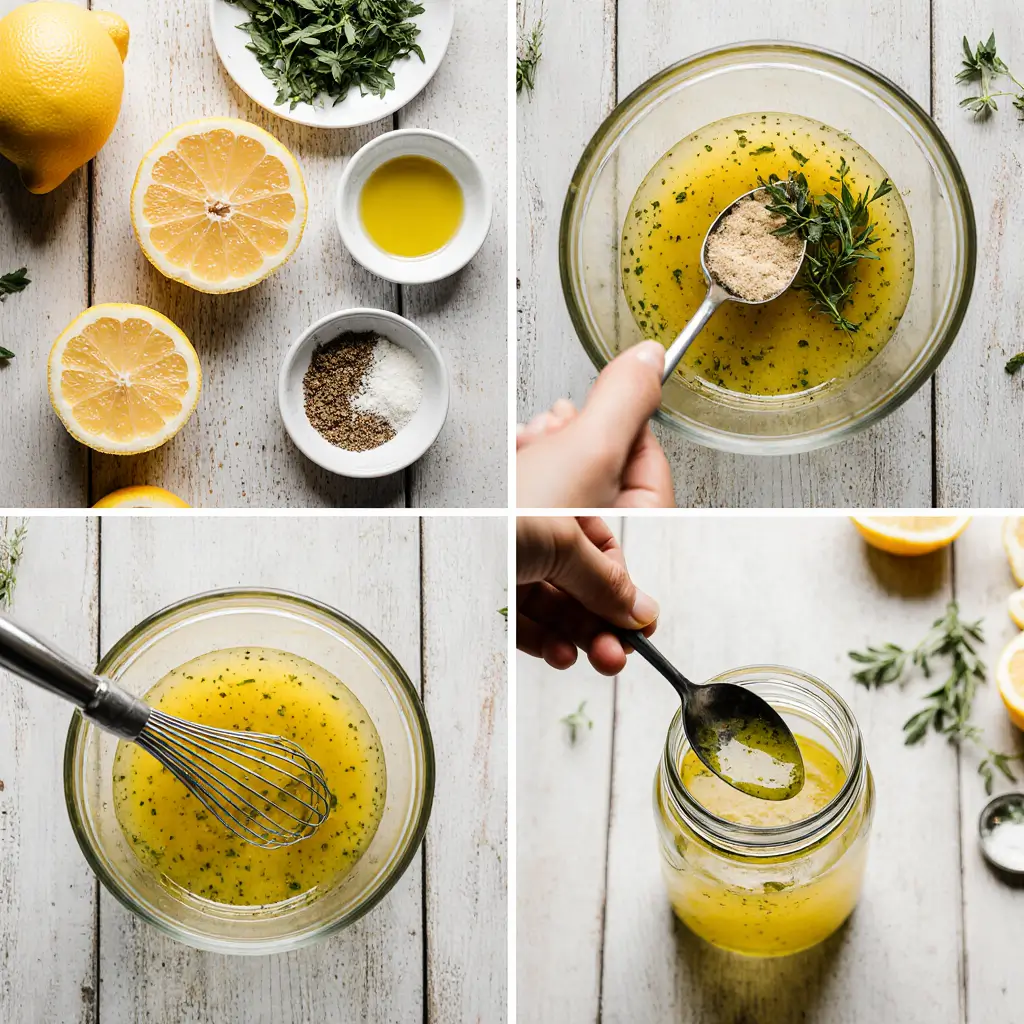
Next, begin adding the olive oil slowly while whisking constantly. Start with just a few drops, whisking vigorously to create the initial emulsion. This step is crucial for your lemon vinaigrette recipe success—rushing here can result in a broken, separated dressing. Once you see the mixture beginning to thicken and lighten in color, you can add the oil in a thin, steady stream while continuing to whisk.
The ideal ratio for this lemon vinaigrette recipe is three parts oil to one part acid, but taste as you go and adjust to your preference. Some people prefer a more acidic dressing, while others enjoy a milder version. The whisking method creates a temporary emulsion that will separate over time, so plan to whisk again before each use.
The Shake-and-Go Jar Method
For busy home cooks, the jar method offers convenience without sacrificing quality in your lemon vinaigrette recipe. Use a clean mason jar or any container with a tight-fitting lid. Add all ingredients except the olive oil first: lemon juice, mustard, salt, pepper, and any optional seasonings like minced garlic or herbs.
Secure the lid tightly and shake vigorously for about 15 seconds to dissolve the salt and combine the base ingredients. Remove the lid, add the olive oil, replace the lid, and shake again for 30-60 seconds. The jar method creates a more temporary emulsion than whisking, but it’s perfect for making larger batches of your lemon vinaigrette recipe.
Store the jar in your refrigerator and simply shake before each use. This method allows you to easily see when the dressing has separated and needs re-emulsification. The jar also serves as both mixing vessel and storage container, reducing cleanup time while keeping your lemon vinaigrette recipe fresh.
Pro Tips for Emulsion Success
Temperature plays a crucial role in creating a stable emulsion for your lemon vinaigrette recipe. All ingredients should be at room temperature when combining—cold oil is harder to emulsify and may result in a broken dressing. If your olive oil has been refrigerated, let it come to room temperature before beginning.
The order of ingredient addition matters significantly in your lemon vinaigrette recipe. Always combine the acid (lemon juice) with the mustard and seasonings first, then slowly add the oil. This allows the mustard to act as an emulsifier, helping to bind the oil and water-based ingredients together more effectively.
If your vinaigrette breaks or separates during preparation, don’t panic—it’s easily fixable. Start fresh with a teaspoon of mustard in a clean bowl, then slowly whisk in the broken dressing. This rescue technique works because you’re essentially starting the emulsification process over with a higher concentration of emulsifier.
Creative Variations to Elevate Your Lemon Vinaigrette Recipe
Herb-Infused Variations
Transform your basic lemon vinaigrette recipe into a garden-fresh masterpiece by incorporating fresh herbs. Basil creates a bright, slightly sweet variation that pairs beautifully with tomato salads and caprese-style dishes. Finely chop two tablespoons of fresh basil leaves and whisk them into your finished dressing, or for a more intense flavor, muddle the basil with the lemon juice before adding other ingredients.
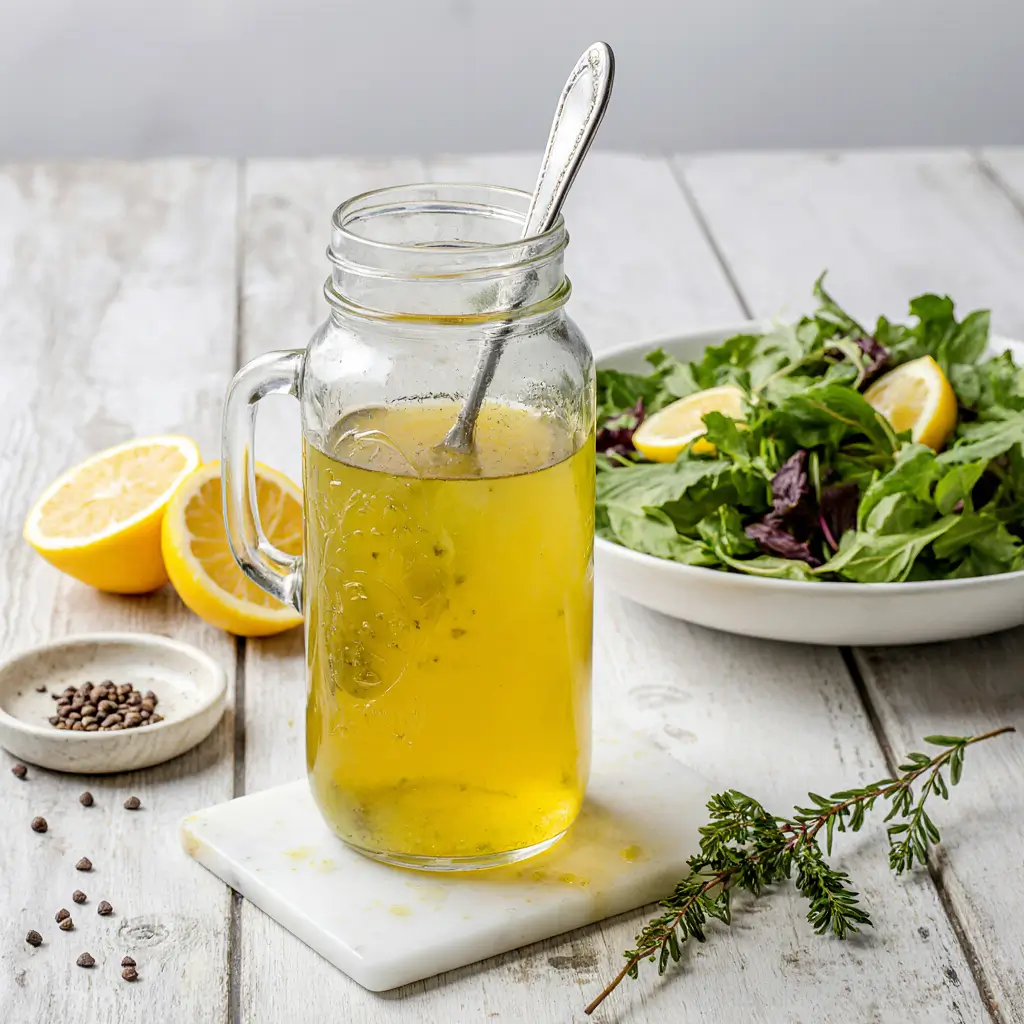
Thyme offers an earthy, slightly floral note that elevates your lemon vinaigrette recipe for use with roasted vegetables or grain salads. Use one tablespoon of fresh thyme leaves, removing them from stems carefully to avoid bitter woody pieces. Oregano provides a Mediterranean flair that works wonderfully with Greek-inspired salads featuring olives, feta, and cucumbers.
For a more sophisticated variation, try tarragon in your lemon vinaigrette recipe. This herb’s subtle anise flavor creates an elegant dressing perfect for delicate lettuces or seafood salads. Use sparingly—one teaspoon of fresh tarragon leaves is usually sufficient, as this herb can quickly overwhelm other flavors if overused.
Garlic and Allium Enhancements
Garlic transforms your lemon vinaigrette recipe into a bold, aromatic dressing that wakes up any salad. Start with one small clove, minced finely or pressed through a garlic press. The key is incorporating the garlic early in the process—add it to the lemon juice and let it sit for five minutes before proceeding. This brief maceration mellows the raw garlic bite while infusing the acid with flavor.
Shallots provide a milder, more sophisticated allium flavor for your lemon vinaigrette recipe. Finely dice one small shallot and add it to the lemon juice at the beginning of the process. Shallots offer a sweet, complex flavor that’s less aggressive than garlic but more interesting than onion powder.
For a unique twist, try incorporating roasted garlic into your lemon vinaigrette recipe. Roasted garlic becomes sweet and mellow, adding depth without harsh bite. Mash one or two roasted cloves with the back of a fork and whisk them into the lemon juice before adding oil. This creates a creamy, flavorful base that’s perfect for heartier salads.
Sweet and Spicy Adaptations
Balance the tartness in your lemon vinaigrette recipe with natural sweeteners for a more complex flavor profile. Honey works beautifully, adding floral sweetness that complements the citrus without overwhelming it. Start with one teaspoon and adjust to taste—remember that a little sweetness goes a long way in balancing acidity.
Maple syrup creates a rich, complex sweetness that pairs particularly well with autumn salads featuring roasted vegetables or dried fruits. Use pure maple syrup rather than artificial versions, and start with half a teaspoon in your lemon vinaigrette recipe. The maple’s earthy sweetness adds depth while maintaining the dressing’s bright character.
For heat lovers, incorporate red pepper flakes or a small amount of hot sauce into your lemon vinaigrette recipe. Start conservatively—a pinch of red pepper flakes or a few drops of your favorite hot sauce can add warmth without overwhelming the delicate citrus flavor. Fresh jalapeño, minced finely, provides heat with a fresh, green flavor that complements the lemon beautifully.
Storage and Usage Guide for Your Lemon Vinaigrette Recipe
Proper Storage Techniques
Your homemade lemon vinaigrette recipe will stay fresh in the refrigerator for up to one week when stored properly. Use a clean, airtight container—glass jars work particularly well because they don’t absorb flavors or odors like plastic containers might. Always use clean utensils when portioning out dressing to prevent introducing bacteria that could spoil your vinaigrette.
The olive oil in your lemon vinaigrette recipe may solidify slightly when refrigerated, which is completely normal and indicates quality oil. Simply remove the dressing from the refrigerator 15-20 minutes before use, or run the container under warm water to return the oil to liquid state. Never microwave your vinaigrette, as heat can degrade the olive oil’s flavor and nutritional properties.
Label your container with the date you made the lemon vinaigrette recipe, and always smell and taste before using if it’s been stored for several days. Fresh lemon juice can ferment over time, creating off-flavors, though proper storage significantly extends the dressing’s life. If you notice any unusual odors, flavors, or mold growth, discard the dressing immediately.
Versatile Applications Beyond Salads
While perfect for green salads, your lemon vinaigrette recipe shines as a marinade for chicken, fish, or vegetables. The acid in the lemon juice helps tenderize proteins while the olive oil keeps them moist during cooking. Marinate chicken breasts for 2-4 hours or fish fillets for 30-60 minutes before grilling or roasting.
Use your lemon vinaigrette recipe as a finishing sauce for roasted or grilled vegetables. Drizzle it over warm roasted Brussels sprouts, asparagus, or zucchini just before serving. The bright acidity cuts through the caramelized flavors while adding moisture and richness to the vegetables.
Grain salads benefit tremendously from your lemon vinaigrette recipe. Toss warm quinoa, farro, or bulgur with the dressing while the grains are still slightly warm—they’ll absorb more flavor this way. Add fresh herbs, nuts, and dried fruits to create complete, satisfying meals that showcase your homemade dressing.
Scaling Your Recipe for Different Occasions
For single servings, reduce your lemon vinaigrette recipe proportionally: use half a tablespoon of lemon juice with one and a half tablespoons of olive oil, plus a pinch each of mustard, salt, and pepper. This small batch approach ensures maximum freshness when you only need enough dressing for one salad.
When entertaining, multiply your lemon vinaigrette recipe by four or six to ensure you have plenty for a crowd. Larger batches actually emulsify more easily and stay stable longer than tiny amounts. Make big batches in a blender or food processor for effortless preparation and superior emulsification.
Consider making a double batch of your lemon vinaigrette recipe even for everyday use. Having homemade dressing ready in your refrigerator makes healthy eating more convenient and encourages you to eat more vegetables. The time investment is minimal, but the payoff in flavor and nutrition is substantial.
Ingredient Breakdown and Nutritional Information
| Ingredient | Amount | Purpose | Nutritional Benefits |
|---|---|---|---|
| Fresh Lemon Juice | 2 tablespoons | Provides acidity and bright flavor | High in Vitamin C, antioxidants |
| Extra Virgin Olive Oil | 6 tablespoons | Base oil, provides richness | Healthy monounsaturated fats, Vitamin E |
| Dijon Mustard | 1/2 teaspoon | Emulsifier and flavor enhancer | Low calorie, adds minerals |
| Sea Salt | 1/2 teaspoon | Enhances all flavors | Essential electrolyte |
| Black Pepper | 1/4 teaspoon | Adds warmth and complexity | Antioxidants, aids nutrient absorption |
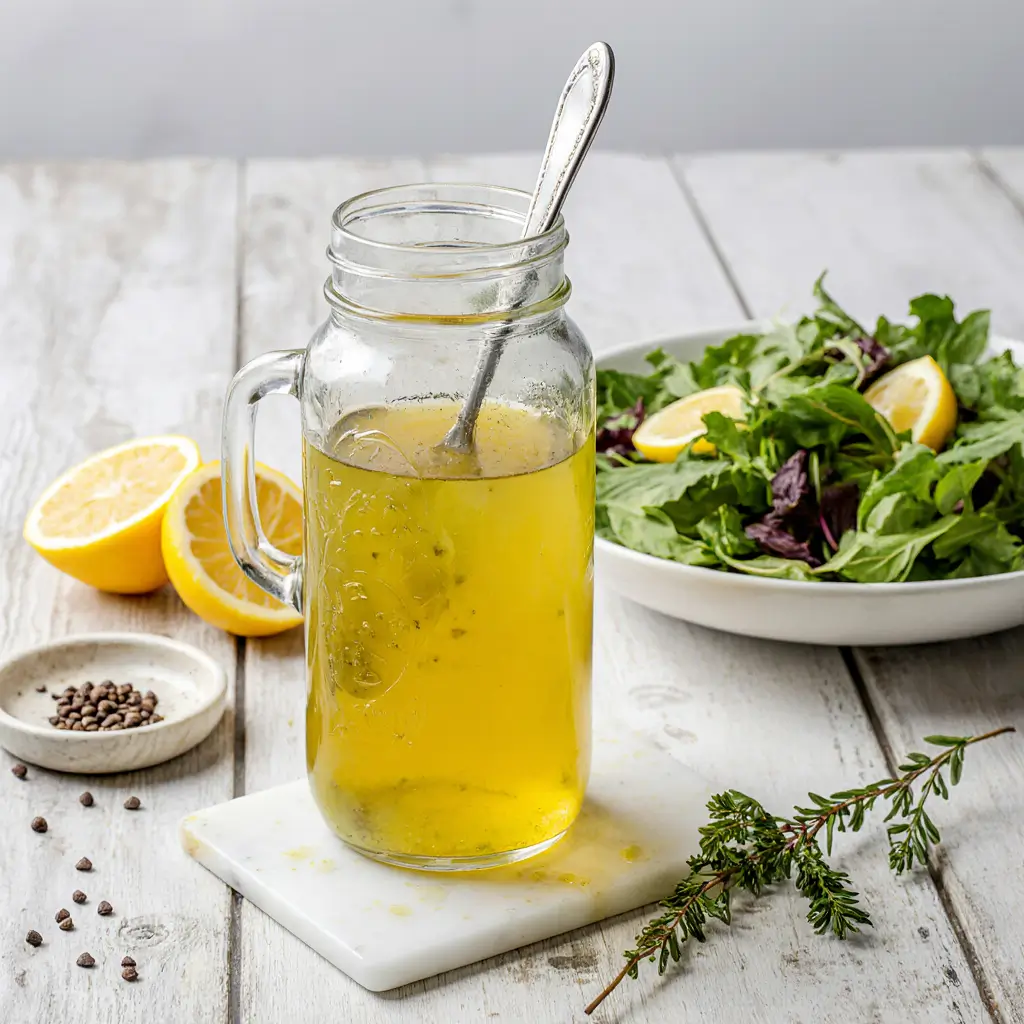
Troubleshooting Common Lemon Vinaigrette Recipe Issues
| Problem | Cause | Solution |
|---|---|---|
| Dressing separates immediately | Oil added too quickly | Start over, add oil drop by drop initially |
| Too acidic/sour | Too much lemon juice | Add more oil or a touch of honey |
| Bland flavor | Insufficient salt or acid | Taste and adjust seasonings gradually |
| Oil won’t incorporate | Ingredients too cold | Bring to room temperature, re-whisk |
| Bitter aftertaste | Over-mixed or poor quality oil | Use fresh, high-quality olive oil |
Frequently Asked Questions About Lemon Vinaigrette Recipe
How long does homemade lemon vinaigrette recipe last in the refrigerator? Your homemade lemon vinaigrette recipe will stay fresh for up to one week when stored in an airtight container in the refrigerator. The fresh lemon juice is the limiting factor—while the olive oil and other ingredients remain stable longer, the citrus juice can develop off-flavors after about seven days. Always smell and taste your dressing before use if it’s been stored for several days, and discard it if you notice any unusual odors or flavors.
Can I make my lemon vinaigrette recipe ahead of time for meal prep? Absolutely! Making your lemon vinaigrette recipe ahead of time is perfect for meal prep and actually allows the flavors to meld and develop. Prepare a batch on Sunday and use it throughout the week for quick, healthy salads. Store it in individual small containers or one larger jar, and always shake or whisk before using since natural separation occurs. The convenience of having homemade dressing ready makes it much easier to eat more vegetables throughout the week.
What’s the best ratio of oil to lemon juice for this lemon vinaigrette recipe? The classic ratio for any lemon vinaigrette recipe is 3:1 oil to acid, which means three tablespoons of olive oil to one tablespoon of lemon juice. However, this can be adjusted based on your taste preferences and the intended use. For a more acidic dressing that cuts through rich foods, try a 2:1 ratio. For a milder dressing perfect for delicate greens, stick with 3:1 or even 4:1. Start with the classic ratio and adjust from there based on your palate.
Can I substitute bottled lemon juice in my lemon vinaigrette recipe? While you can technically substitute bottled lemon juice in your lemon vinaigrette recipe, the results won’t be nearly as flavorful or bright. Fresh lemon juice contains volatile oils and compounds that provide complexity and vibrancy that bottled versions lack. Bottled lemon juice often contains preservatives that can create off-flavors in your dressing. If you must use bottled juice due to convenience, choose organic varieties without additives, but plan to use a bit more to achieve similar flavor intensity.
How can I fix a broken or separated lemon vinaigrette recipe? If your lemon vinaigrette recipe breaks or separates, don’t throw it away—it’s easily fixable! Start with a teaspoon of Dijon mustard in a clean bowl, then slowly whisk in the broken dressing, starting with just a few drops and gradually increasing the stream as the emulsion reforms. Alternatively, you can start with a tablespoon of the broken dressing in a clean bowl and slowly whisk in the remainder. The key is restarting the emulsification process with a higher concentration of emulsifier.
Ready to transform your salads forever? Grab some fresh lemons and quality olive oil, and whip up this game-changing lemon vinaigrette recipe today. Your taste buds—and your wallet—will thank you for making the switch to homemade dressing that’s fresher, healthier, and infinitely more delicious than anything you’ll find in a bottle.
Are You Try This Recipe ?
There are no reviews yet. Be the first one to write one.

